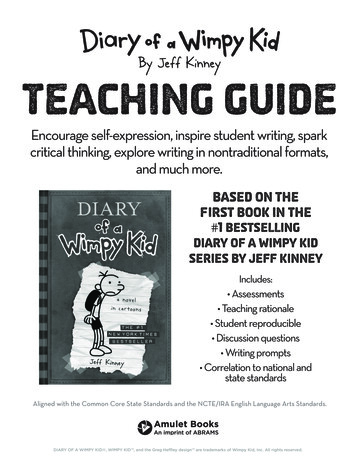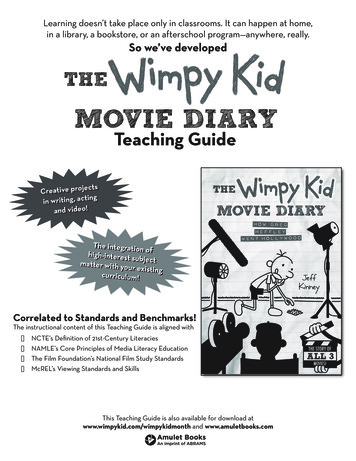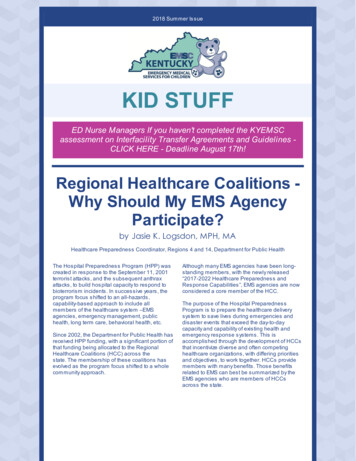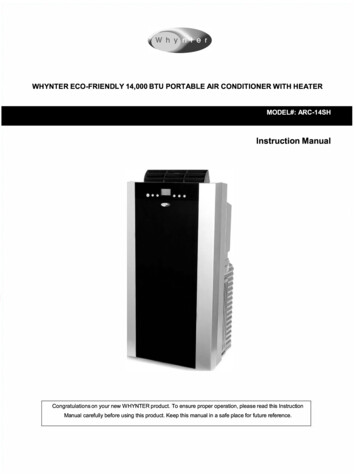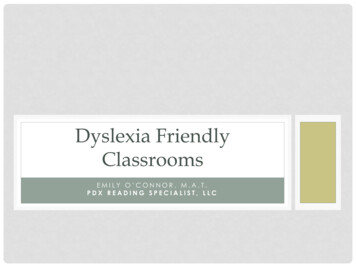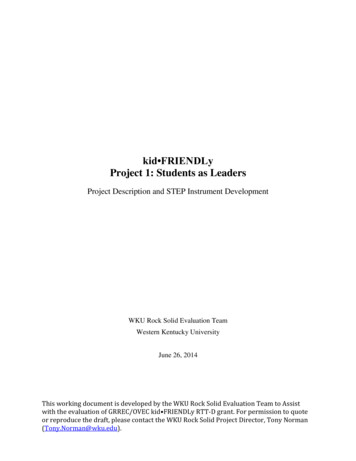
Transcription
kid FRIENDLyProject 1: Students as LeadersProject Description and STEP Instrument DevelopmentWKU Rock Solid Evaluation TeamWestern Kentucky UniversityJune 26, 2014This working document is developed by the WKU Rock Solid Evaluation Team to Assistwith the evaluation of GRREC/OVEC kid FRIENDLy RTT-D grant. For permission to quoteor reproduce the draft, please contact the WKU Rock Solid Project Director, Tony Norman(Tony.Norman@wku.edu).
THE LEADER IN ME1ABSTRACTThe Leader in Me Program is designed to improve student conduct, performance, andethical development through the use of Stephen Covey’s 7 Habits of Highly Effective People,which were developed in Covey’s 1989 book of the same name. This document will provide anessential overview of Covey’s 7 Habits, as well as an overview of how they are beingimplemented through The Leader In Me program at schools throughout Kentucky. It will alsoexamine the ways in which the effectiveness of this program is being evaluated by the RockSolid Evaluation Project at Western Kentucky University.
THE LEADER IN ME2THE 7 HABITS OF HIGHLY EFFECTIVE PEOPLE AND THE LEADER IN MEIntroductionThe Rock Solid Evaluation Project at Western Kentucky University was established toevaluate the Green River Regional Educational Cooperative (GRREC) & Ohio ValleyEducational Cooperative (OVEC)’s Race to the Top—District (RTT—D) program,kid·FRIENDLy (Kids Focused, Responsible, Imaginative, Engaged, and Determined to Learn),which is an implementation of The Leader in Me (TLIM) program. To this end, an evaluationinstrument has been developed to gauge the potential effectiveness of TLIM in changing studentleadership characteristics and social and emotional development.Based on Stephen Covey’s The 7 Habits of Highly Effective People (Covey, 2013) andSean Covey’s The 7 Habits of Happy Kids (Covey, 2008), TLIM is a school-wide program thatwas developed by Muriel Summers and designed to improve school performance and studentbehavior (FranklinCovey, 2014a). TLIM is being implemented in stages, with Cohort IKid·FRIENDLy schools in GRREC & OVEC regions receive the first treatment and Cohort IIreceiving said training at a later date. The interdependent roles of GRREC, OVEC, Rock Solid,and FranklinCovey (the publisher and owner of TLIM) are complex, and the logic model foundin Appendix A allows for a clearer visualization of their relationships than can be provided here.The 7 Habits of Highly Effective PeopleBefore examining The Leader in Me program, one should at least be familiar with the 7Habits of Highly Effective People. They are as follows:1. Be Proactive2. Begin with the End in Mind3. Put First Things First
THE LEADER IN ME34. Think Win-Win5. Seek First to Understand, Then to be Understood6. Synergize7. Sharpen the SawEach of these habits was noticed by Covey, elaborated upon them at some length.Be ProactiveThis habit is essentially that of taking responsibility for one’s own actions, conduct, anddecisions. It is distinguished from that of being reactive, meaning that a person only reacts to thatwhich happens to him of her. This habit also encourages a person to think about matters that arerelevant to him or her and over which a person has some control, which are categorized as beingin person’s “Circle of Concern” and “Circle of Influence,” respectively (“Habit 1: Be Proactive”).Begin with the End in MindThis habit is that of developing clear and meaningful goals, and beyond that, of knowingboth what a one wants and why one wants it. The habit can be cultivated through the creation ofa Personal Mission Statement, which serves as a declaration of what one wants to do and be(“Habit 2: Begin with the End in Mind”).Put First Things FirstThis habit is that of prioritizing. In order for it be effective, one must have a clear list ofpriorities and goals, which should have been developed under the impetus of the first two habits(“Habit 3: Put First Things First”).Think Win-Win
THE LEADER IN ME4In order to apply the habit of Thinking Win-Win, one focuses on mutual gains andcooperation rather than competition. It is not meant to mean that someone must always be nice,but rather that he or she acts in a principled way (“Habit 4: Think Win-Win”).Seek First to Understand, Then to be UnderstoodIn order to apply this habit, one must first listen to what another person is saying, ratherthan simply use what is being said to develop a response (“Habit 5: Seek First to Understand,Then to be Understood”).SynergizeThis habit is that of learning to work creatively with others. In order to do this, one mustcollaborate with an open mind and a willing to consider different ways of thinking and differentperspective (“Habit 6: Synergize”).Sharpen the SawThe habit of Sharpening the Saw is that of taking care of one’s health and wellbeing.Aside from relating to obvious matters of physical health (such as nutrition and exercise),Sharpening the Saw also concerns building meaningful relationships, educating oneself, andcultivating one’s spiritual development (“Habit 7: Sharpen the Saw”).The Leader in MeThe Leader in Me program was started in 1999 by Muriel Summers, principal of A.B.Combs Elementary, who, after attending a 7 Habits of Highly Effective People seminar, decidedto integrate them into her school’s culture and teaching methods. The program was successfuland was eventually deployed at other schools (“What is The Leader In Me?”).Deployment of The Leader in Me
THE LEADER IN ME5The Leader in Me is designed to do more than simply teach the 7 Habits to students.Rather, it is designed to integrate them into the core values of the institution. Thus, it deploymentis done on a school-wide basis that requires both time and effort.The timeline and steps for the process are thus:—Year 1 (“Establishing a Culture of Leadership”)—1. Develop a clear vision of the school’s overall goals and objectives (one day of stafftraining)2. Teach staff about the vision, goals, and language of TLIM (three days of staff training)3. Teach staff how to implement TLIM in a comprehensive way across the curriculumand how to create and assign leadership roles (one day of staff training)4. Select “Lighthouse Team”—a team of about six staff members—and teach themhow to implement and lead TLIM as it progresses through the school (one day ofLighthouse Team training)—Year 2 (“Applying the Tools of Leadership”)—1. Teach all faculty and staff how to further develop TLIM implementation in the school,how to help students use leadership notebooks, and how to make best use of StudentLeadership Roles (one day of staff training).2. Review the success of the program thus far and the role of the Lighthouse Team andteach the Lighthouse Team and administrators how to effectively develop andtrack school-wide goals (one day of administration and Lighthouse Team training)(“How do School Implement The Leader in Me?”)Ideally, this program and its various components will allow students to function as moreindependent and capable members of their school and community.
THE LEADER IN ME6Staggered Deployment of TLIM InterventionDue to funding and resource limitations, TLIM will be deployed at schools in two cohortgroups. Cohort I will extensive deployment of TLIM this year (2014), whereas Cohort II willbegin extensive deployment of TLIM next year (2015). In addition to allowing teaching, training,and developmental resources to be used more effectively and distributed over a wider area, thisstrategy will also allow the Rock Solid Research Team to evaluate normal changes in studentattitude and performance, as it would normally occur without TLIM intervention.Application of TLIM in schoolsTLIM is an all-inclusive approach to school-wide cultural change. As such, it relies onpervasive and persistent promotion of the key values of the 7 Habits. The seven habits areinculcated in students using a variety of methods, including:1. Placing signage and recognizable symbols relating to TLIM in hallways, classrooms,and gymnasiums. For example, in Jody Richards Elementary school of Warren County,Kentucky, one school in which TLIM was being deployed, the signage was bright,obvious, and located in such a way that students were essentially guaranteed to see itwhenever they passed through the halls, spent time in the library, or even ate in thecafeteria.2. Integrating TLIM messages into core school communications, such as the schoolmission and motto. For example, one TLIM school (Jody Richards Elementary) has as amission statement: “To being with the end in mind and be college, career, and citizenshipready,” and: “Leaders do what is right, even when no one is watching,” as a motto.3. Integrating data-driven performance tracking into classroom instruction. This is donethrough the use of Leadership Notebooks, Data Scoreboards, and Data Notebooks.
THE LEADER IN ME7The Leadership Notebooks are designed to enable students to set goals for themselvesand articulate their objectives. Data Notebooks differ in that they are designed to providestudents with information for tracking their academic and personal performance. Studentinformation and performance is also presented on entire-school Data Scoreboards, which allowstudents to judge their performance in relation to their peers.It should be noted that TLIM has not been implemented in all schools within theGRREC/OVEC region. This is partially due to a staggered deployment of the TLIM programbeing used as a method to optimize TLIM resource usage. Additionally, the TLIM program hasnot systematically been deployed at high schools in the GRREC/OVEC region due to it not beingdesigned to be used above middle-school level. Rather, a separate program, Goal-driven,Resilient, Influential Teens (GRIT), will be deployed at the high-school level beginning in thesummer of 2014. This program will incorporate Stephen Covey’s 7 Habits, but in a mannerbetter suited to adolescent-oriented instruction.Several different events related to TLIM and GRIT have recently occurred or will occurin the near future. Below are the major events and their status. It should be noted thatdetermining the exact chronology of these events may be difficult as they will occur at differentschools at different points in time. 7 Habits of Highly Effective People Workshops (also called “Vision/7 HabitsSignature Training”) (for all school levels)Duration: 3 days of on-site trainingSchools HAving Received Education (SHARE): All schools, both cohorts byAugust 2014
THE LEADER IN ME 8Achieving Schoolwide Goals (ASG), Faculty Lighthouse Team (FTT) training (forall schools)Duration: 1 day of on-site ASG training; 3 days of on-site training FTT trainingSHARE: All school’s Lighthouse Teams Empowerment Day training (for all elementary and middle schools’ staff)Duration: 1 day of on-site trainingSHARE: All elementary and middle schools’ staff; date of anticipatedcompletion unknown Great Leaders Training (for middle schools and high schools)Consisting of: Professional, on-site training, with Coach-Coaching andSupportDuration: 4 days of on-site visits; 2 days of virtual trainingSHARE: 5 middle schools Implementation Training (for elementary and middle schools)Consisting of: Professional training for faculty and staffDuration: 1 day of on-site trainingSHARE: Summer 2013: All Cohort I schoolsSummer 2014 (by no later than end of): All Cohort II schools Student Lighthouse/Student GRIT training (for all middle schools and high schools)Duration: 1 day of on-site trainingSHARE: All middle and high schools, no later than autumn 2014 Virtual Certifications: 7 Habits; 7 Habits of Highly Effective Families (for all schools)Duration: Variable
THE LEADER IN ME9SHARE: All Cohort I staff members. Cohort II staff members will be trained atLater date. Virtual Leadership Tutorial, “How to Teach the 7 Habits” (for elementary and middleschools)Duration: UnspecifiedSHARE: Unknown at current date; however, in both cohorts (Cohort I and CohortII), 2 staff members in each elementary school and 3 staff members in eachmiddle school will receive trainingInitial Deployment of The Leader in Me (TLIM)The following are some of the defining characteristics of TLIM training and deploymenttechniques as practiced by the service provider, FranklinCovey:1. Initial training is provided by senior educators, principals, counselors, superintendents,and other professionals trained by FranklinCovey, using extensive online and classroominstruction.2. The schools and their staff are provided access to “resources online, videos, lessonplans,” and the codes necessary to access this content.3. Trainer performance and qualifications are monitored on an ongoing basis byFranklinCovey, with frequent conference calls and resource-sharing sessions madewithin the FranklinCoveyTLIM training community.(L. Brewer, personal communication, May 21, 2014)Lighthouse Status: Purpose and Requirements
THE LEADER IN ME10Lighthouse Status is the ultimate goal of any school undergoing TLIM certification. Itindicates that the institution has become “a showcase for leadership skills,” and it does so bymeeting criteria specified by FranklinCovey, including:1. Has a Lighthouse Team—Team meets regularly, verifies that implementation TLIM is going smoothly2. Has productive staff collaboration—Staff systematically helps in the mentoring and modeling of leadership principles3. Promotes family and community engagement—Families and community are provided with fundamental knowledge of TLIM, how it isimplemented, and what they can do to support its implementation and goals4. Has and promotes a leadership environment—The environment of the school systematically reinforces TLIM/leadership message,including through the use of signage and other reinforcements as mentioned in the firstpoint of the “Application of TLIM in schools” section of this document5. Has a Leadership Instruction and Curriculum—TLIM/7 Habits are reinforced through the lesson plans and curriculum content of theschool6. Has and promotes effective student leadership—Different students are given the title of “leader” and allowed to create and plan differentactivities across the school that build upon the leadership/TLIM message7. Has leadership events—Participants from the surrounding community, as well as other schools, are educated asto what the school is doing to implement TLIM
THE LEADER IN ME118. Implements goal setting and tracking—Goals at the school, classroom, and individual-student level are tracked and presentedthroughout the school, such as was mentioned in the third point of the “Application ofTLIM in schools” section of this document9. Produces measurable results—Tracking of data reveals meaningful improvement in school performance or a reductionin undesirable outcomes. Information of a qualitative form, including anecdotal evidence,may also be used as evidence of school improvement(FranklinCovey, 2014b, p.61-62).The Structure and Function of kid FRIENDLyThe kid FRIENDLy (kids Focused, Responsible, Imaginative, ENgaged, and Determinedto Learn) is a program developed and administered by the Green River Regional EducationalCooperative (GRREC) and Ohio Valley Educational Cooperative using 40,000,000 USD offunds from the United States Department of Education’s Race to the Top—District competition.The program now covers 22 districts, 113 schools, and approximately 4,000 teachers.It is designed to implement TLIM across these educational institutions and to cultivatestudents as leaders. The program has four essential components, including Students as Leaders(which largely involves the actual application of TLIM at a student-centric level); LeadersDeveloping Leadership (which provides training to school principals); Competency-basedTeaching (which is designed to enable students to focus on content mastery, rather than gradecompletion); and Personalized Learning for All Students (which is designed to enable allstudents to learn in a manner appropriate to them as individuals).
THE LEADER IN ME12The kid FRIENDLy grant provides funding for five categories of resources. They are asfollows:1. Consultants (who provide outside expertise to help develop the program)2. Professional development (which provides training for educational staff)3. Technology (which provides useful school-wide communications and learning tools)4. Curricular resources (which provides essential learning materials)5. Staffing (which will consist of a project manager, student leadership coach, leadershipmentor, up to three cognitive coaches, up to six college/career readiness counselors, andup to four personnel, known as “preschool pals,” employed to help families prepare theirchildren for kindergarten)All of these various resources help contribute to the ability of kid FRIENDLy to serve itscommunity.Structure and Function of the Rock Solid Evaluation ProjectThe Rock Solid Evaluation Project is a group of academics and professional researchersat Western Kentucky University dedicated to evaluating the effectiveness of TLIM as it isdeployed throughout the GRREC and OVEC regions.In order to effectively evaluate the impact of TLIM, the Rock Solid Evaluation Projecthas undertaken the development of a novel research instrument and assessment system basedupon the most psychometric research and best-practice principles. The culmination of theseefforts is the STudent Engagement And Performance (STEP) instrument.Purpose of the InstrumentThe STEP instrument was designed to measure students’ baseline and ongoingperformance of areas closely related to the 7 Habits. In order to do this, Rock Solid researchers
THE LEADER IN ME13developed a set of terms and major concepts that allowed the categories of questions found in theinstruments used to be mapped to 7 HabitsWhile fundamentally original, the STEP instrument was developed upon the foundationsof a substantial body of existing instruments. Some of these instruments included:1. Devereux Student Strengths Assessment (DESSA)—a “72-item, standardized normreferenced behavior rating scale that assesses the social-emotional competencies thatserve as protective factors for children in kindergarten through the eighth grade”(LeBuffe, Shapiro, and Naglieri, 2008)—This instrument was one of the key models forthe STEP instrument.2. Behavioral and Emotional Rating Scale—Second Edition (BERS-2)—a test that“measures several aspects of a child's strength: interpersonal strength, involvement withfamily, intrapersonal strength, school functioning, affective strength, and career strength”(“BERS-2,” 2012)3. High School Survey of Student Engagement (HSSSE)—an instrument that is “acomprehensive survey on student engagement and school climate issues” (“HSSSE:Home,” 2014)*4. My Class Inventory (MCI)—an instrument that measures “Satisfaction, Friction,Competitiveness, Difficulty, and Cohesiveness” (Prawat and Solomon, n.d., p. 3).5. Social Skills Improvement System (SSIS)—an instrument that rates “Social Skills,Problem Behaviors, and Academic Competence” (“SSIS Rating Scales,” 2014)6. Child Self-Control Rating Scale (CSCRS)—a 33-item self-reporting scale that allowsmeasure's a child level of self-control (Rohrbeck, Azar, and Wagner, 1991, p. 179)7. Emotion Regulation Checklist (ERC)—a measure of emotional regulation ability
THE LEADER IN ME148. Learning and Study Strategies Inventory (LASSI)—a “10-scale, 80-item assessment ofstudents' awareness about and use of learning and study strategies related to skill, willand self-regulation components of strategic learning” (“Overview of LASSI,” 2014)9. Learning Environment Inventory (LEI)—an instrument that “measures studentperceptions of the social climate of high school classrooms” (Fraser, Anderson, andWalberg, 1982, p. 6)10. The National Center for School Engagement School Engagement Survey (SES)—an instrument that measures behavioral engagement, cognitive engagement, andemotional engagement (National Center for School Engagement, 2006, p. 2-3).The (10) Motivated Strategies for Learning Questionnaire (MSLQ), (11) Self-Control andSelf-Management Scale (SCMS), (12) Social-Emotional Wellbeing Survey (SEWB), and (13)Self-Regulation Questionnaire (SRQ) were also used as resources for the development of theSTEP instrument.HSSSE and Student Engagement* The HSSSE was of considerable importance in the development of this instrument,partially because it provided a clear line of questioning to measure the mechanisms ofengagement, a concept which is distinct from that of motivation. It is also particularly worthnoting that intrinsic motivation (the internal drive within students to succeed in school) lessens asstudents move from elementary school to middle and high school (Gottfried, Fleming, &Gottfreid; Gottfried & Gottfried, as cited in Yazzie-Mintz & McCormick, 2012, p. 746), and thusit is a worthwhile focus of study.Roughly speaking, engagement can be sorted into three different categories: behavioralengagement, emotional engagement, and cognitive engagement (Yazzie-Mintz & McCormick,
THE LEADER IN ME152012, p. 747). Each of these categories of engagement encompasses several differentcomponents of behavior or thought. They are listed as follows: Behavioral engagement: “positive behavior, effort, and participation” (Yazzie-Mintz& McCormick, 2012, p. 747) Emotional engagement: “interest, identification with school, a sense of belonging,and a positive attitude about learning” (Finn; Marks; Newmann, Wehlage & Lanborn;& Willms, as cited in Yazzie-Mintz & McCormick, 2012, p. 747) Cognitive engagement: “self-regulation, learning goals, and a measure of students’investment in their learning” (Fredericks et al.; Jimerson, Campos, & Grief;Linnenbrink & Pintrich, as cited in Yazzie-Mintz & McCormick, 2012, p. 747)The Item-writing ProcessPreliminary MappingAfter a pool of instruments covering the major concepts of interest was compiled,relevant questions from each instrument were sorted and categorized as they related to the 7Habits. In some instances, evaluation-instrument vendors, such the creators of the DESSA,provided construct mapping between their questions and meaningful terms. Thus, the only realtask of the Rock Solid team was to map these terms to their corresponding 7 Habits. The chartbelow shows how the Rock Solid did such mapping, which was undertaken in a commonsensicalmanner using the definitions for each construct (as provided by the publisher) and the 7 Habits(as defined by the 7 Habits literature).
THE LEADER IN ME16Figure 1. Relationship mapping between the 7 Habits and the DESSA constructs as conceived byRock Solid team, with each of the 7 Habits on the left and the DESSA constructs on the right.Each question from this pool was made use of as a question with the potential to bemodeled and examined. Given the relatively straightforward mapping system, building arelationship between the 7 Habits and the questions on the DESSA was relatively easy. Theseterms have specific meanings in the research texts used in the course of developing the STEPinstrument. A list of meaningful definitions extracted from the literature can be found inAppendix D.
THE LEADER IN ME17Figure 2. A model showing the complete relational map between the 7 Habits, DESSA constructs,and DESSA questions. (Each question, when not indicated otherwise should start with “Duringthe past 4 weeks, how often did the child . . . ”)Other questions from the aforementioned instruments were mapped according to similarconstruct-specific models. After this was completed, the actual items were constructed.Instrument Development (Composition of Questions)Item writing for the STudent Engagement And Performance (STEP) instrument wasconducted by various members of the Rock Solid Team. Two versions of the instruments weredeveloped: one version for grades K through 3 and another version for grades 4 to 12, with thegrades 4 to 12 version of the test having been developed first and then the grades K through 3version being derived from it.Unlike the DESSA, the STEP instrument has, not seven, but six categories, which arelisted in the table below, also containing sample questions from both the grades K through 3 andgrades 4 to 12 versions of the STEP instrument. The higher-level version of the STEP instrumentwas the first developed. It was then simplified in order to provide young students with an easierto understand version of the instrument.Below is a table outline the substantial differences in the various versions of the STEPinstrument:CharacteristicsNumber of itemsContentGrades: K-357Engagement, 7 habits,Type(s) ofquestionsBinary, drop-downselection, multi-choiceGrades: 4, 6, 8, 9, 1183Engagement, 7 habits, dropout indicators4-point Likert, binary, dropdown selection, multi-choiceTable 1. Comparison of different versions of STEP instrument.Grades: 5, 7, 10, 1273Engagement, 7 habits4-point Likert, binary,drop-down selection,multi-choice
THE LEADER IN ME18The rationale for grades 4, 6, 8, 9, and 11 being given a longer survey than grades 5, 7, 10,12 was to reduce survey fatigue for the second group while still providing meaningfulinformation on the attitudes of students throughout the educational process. Complete version ofeach survey can be found in Appendixes B and C.Construct/DomainCognitive EngagementEmotional EngagementSub-ConstructPurpose ofschoolingExample Items (K-3)I like to learn in school.I go to school because I like myfriends.Example Items (4-12)I go to school because I love tolearn.I go to school because I want to goto college.LearningeffortsAttitudestoward school& teachersFeelings ofbelongingI work hard in school.I learn everything I can in school.I am happy at school.My classroom is fun.I work hard on my schoolwork.I enjoy working on difficult tasks.My classroom is a fun place to be.I think the teachers at my schooltreat students fairly.I feel like my opinions arerespected in this school.I can talk to my teachers about myproblems.I get in trouble at school.I fight with my classmates.I help my friends when they arehaving problems.I care about how others feel.I finish tasks when asked.I make decisions after thinkingcarefully.I can handle whatever comes myway.I can solve most problems if Iwork hard.Behavioral EngagementSocial EngagementIndependence (Habits1, 2, 3 & 7)Independence (Habits4,5, & ical wellbeingSocialCompetence/Communication skillsMy teachers listen to me.I can talk to teachers about myproblems.I follow the rules at school.I get in trouble at school.I like to make new friends.I help my friends when they needhelp.I keep my promises.I think before I make choices.I can deal with whatever happensto me.I can solve my problems.I don’t get mad when my feelingsget hurt.I eat healthy foods.I share things with other people.I am comfortable around peoplewho are different from me.Table 2. STEP instrument constructs and sample related items.I stay calm when my feelings gethurt.I exercise every day.I am comfortable around peoplewho are different from me.I put myself in other people'sshoes.
THE LEADER IN ME19Once the initial questions were developed, they were informally piloted and tested so asto provide the item-writers with feedback. Items that were found to be difficult to understand, oflow validity, or redundant were eliminated.Data Collection MethodsOnce the STEP instrument was finalized, deployment commenced. This was done usingthe Qualtrics (Qualtrics.com) online survey administration system. The Qualtrics systemautomatically compiles the results from students into district-level and school-level files. Theseresults could then be accessed using either Microsoft Excel or IBM SPSS software packages.The Rock Solid Evaluation Team intends to administer the STEP instrument for the duration ofthe intervention to produce analyses every year and at the end of the four-year term of theTeam’s research project.In a later section, these results will be analyzed and interpreted.
THE LEADER IN ME20ReferencesBERS-2: Behavioral and emotional rating scale—Second edition. (2012). Retrieved from thePro-Ed website: ID 3430Covey, S. (2008). The 7 habits of happy kids. New York, NY: Simon & Schuster.Covey, S. (2013). The 7 habits of highly effective people: Powerful lessons in personal change.New York, NY: Simon & Schuster.LeBuffe, P., Shapiro, V., & Naglieri, J. (2008). Devereux student strengths assessment (DESSA).Lewisville, NC: Kaplan Press.LeBuffe, P., Shapiro, V., & Naglieri, J. (2009). DESSA: Devereux student strengths assessment:K-8th grade: A measure of social-emotional competencies of children in kindergartenthrough eighth grade. Lewisville, NC: Kaplan Press.FranklinCovey. (2014a). What is The Leader in Me? Retrieved from -me/FranklinCovey. (2014b). The Leaderi in Me Symposium: 2014: Kentucky. West Valley City:Utah.Fraser, B., Anderson, G., & Walberg, H. (1982). Learning environments: Manual for learningenvironment inventory (LEI) and my class inventory (MCI). Retrieved from ERICdatabase. (ED223649).Habit 1: Be proactive. (n.d.). Retrieved from the FranklinCovey website: 1.phpHabit 2: Begin with the end in mind. (n.d.). Retrieved from the FranklinCovey website: 2.php
THE LEADER IN ME21Habit 3: Put first things first. (.n.d.). Retrieved from the FranklinCovey website: 3.phpHabit 4: Think win-win. (n.d.). Retrieved from the FranklinCovey website: 4.phpHabit 5: Seek first to understand, then to be understood. (n.d.). Retrieved from theFranklinCovey website: 5.phpHabit 6: Synergize. (n.d.). Retrieved from the FranklinCovey website:
Based on Stephen Covey’s The 7 Habits of Highly Effective People (Covey, 2013) and Sean Covey’s The 7 Habits of Happy Kids (Covey, 2008), TLIM is a school-wide program that was developed by Muriel Summers and designed to improve school performance and student behavior (FranklinCovey, 2
